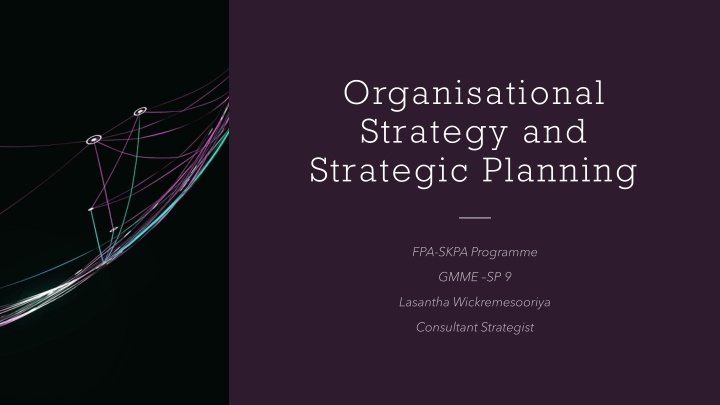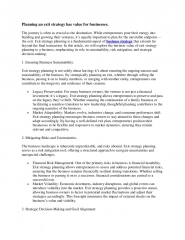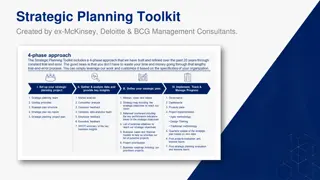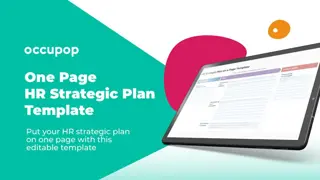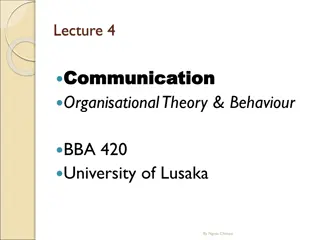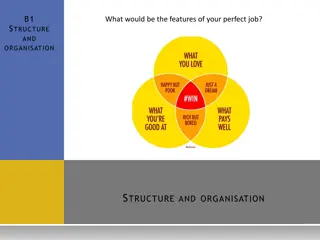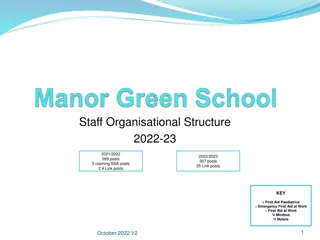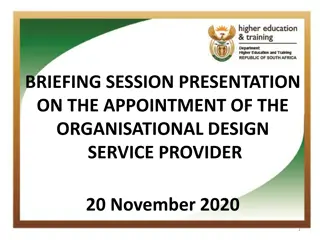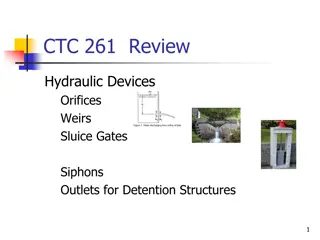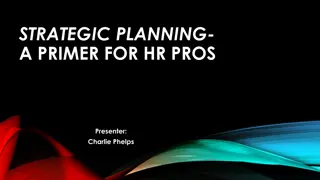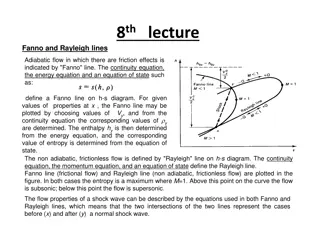Organisational Strategy and Strategic Planning - Decision Flow and Execution
Explore the flow of strategic planning encompassing stakeholder analysis, action planning, identifying issues, evaluation, environmental analysis, and strategy execution translating initiatives into action. Learn about building an organization capable of proficient strategy execution through critical resources and capabilities development.
Download Presentation

Please find below an Image/Link to download the presentation.
The content on the website is provided AS IS for your information and personal use only. It may not be sold, licensed, or shared on other websites without obtaining consent from the author.If you encounter any issues during the download, it is possible that the publisher has removed the file from their server.
You are allowed to download the files provided on this website for personal or commercial use, subject to the condition that they are used lawfully. All files are the property of their respective owners.
The content on the website is provided AS IS for your information and personal use only. It may not be sold, licensed, or shared on other websites without obtaining consent from the author.
E N D
Presentation Transcript
Organisational Strategy and Strategic Planning
The Decision Flow for Strategic Planning Stakeholder analysis Plan of Actions Identifying Strategic Issues Monitoring & Evaluation Environmental Analysis Strategic Initiatives Mandate Aspirations Structure Resources & Capability Analysis Feedback loop
Strategy execution is about translating an organization's strategic initiatives into action
Resources & Capabilities Environment Stakeholders Who, what, where, when, what cost? Action points to achieve objectives Goals & Strategic Initiatives Strategic Issues Vision Mission Objectives
EXECUTING STRATEGY Strategy Execution: o o o 10 6
Good strategy execution requires a team effort. All managers have strategy-executing responsibility in their areas of authority, and all employees are active participants in the strategy execution process. 1 0 7
BUILDING AN ORGANIZATION CAPABLE OF GOOD STRATEGY EXECUTION: THREE KEY ACTIONS 01 02 03 Staffing Staffing: Assemble a strong management team and a cadre of competent employees. Developing Developing: Renew, upgrade, and revise resources and capabilities to match chosen strategy. Structuring Structuring: Create strategy-supportive organization capable of good strategy execution. 10 8
Building an Organization Capable of Proficient Strategy Execution: Building an Organization Capable of Proficient Strategy Execution: Three Types of Paramount Actions Three Types of Paramount Actions
DEVELOPING AND BUILDING CRITICAL RESOURCES AND CAPABILITIES Approaches to Build Building Approaches to Build Building and Strengthening Capabilities and Strengthening Capabilities Access capabilities Access capabilities via collaborative via collaborative partnerships partnerships Develop Develop capabilities capabilities internally internally Acquire capabilities Acquire capabilities through mergers through mergers and acquisitions and acquisitions 1 0 1 0 1 0 1 0
ACTION PLANS Strategic Theme Strategic Issue Strategic Initiative Objectives Action Plan What? (Activity) When? (Timing) Where? (Location) Who? What Cost? (Budget) (Person responsible)
MONITORING OR EVALUATION? Local researchers conduct a study to determine if there are more people with possible TB symptoms coming to DOTS clinics as a result of a media campaign to promote TB screening. A district manager reports on how many nurses were trained on interpersonal communication skills for her quarterly donor report.
Improve program implementation Data on program progress and implementation Improve program management and decision making Improve What is the purpose? Inform Inform future programming Inform stakeholders Accountability (donors, beneficiaries) Advocacy Inform
WHO NEEDS, USES M&E INFORMATION? Purpose Purpose User User To Improve program implementation Board, Managers To Inform and improve future programs Donors Governments Technocrats Inform stakeholders Communities Beneficiaries
WHO CONDUCTS M&E.? Program implementer Stakeholders Beneficiary Participatory process
Program Framework: Analyze and systematically lay out program elements Program How to carry out M&E? Identify Identify key elements to monitor and evaluate. Key Determine and describe Determine and describe the measures to be used for monitoring and evaluation Features Develop M&E Framework and action plans, including data collection and analysis, reporting and dissemination of findings. Develop
What is a GOAL? Decrease morbidity and mortality due to TB in Country X. Reduce prevalence of TB by 50%. Eliminate stigma of TB in our communities.
What is an OBJECTIVE? Objectives Activities Goal
Objective (examples) Aggressively advocate to increase national HIV budget by 8% each year for the next four years. Double the percentage of secondary school students who can correctly identify TB symptoms by 2015. Design and pilot a treatment support program for newly released drug offenders with HIV by 2025.
INPUTS Examples Examples Money Staff Volunteers Policies, guidelines Equipment Partners
ACTIVITIES Examples Examples Training events Meetings Events Outreach Home visits
OUTPUTS Examples Examples Number of people rehabilitated Number of brochures produced Number of policymakers reached with advocacy activity
OUTCOMES Examples Examples Increased funding for HIV after lobbying meeting Short: Improved attitudes toward HIV patients among nurses after a training Medium: Increased satisfaction of HIV clients Long: HIV clients stay in treatment longer and remain connected
INDICATORS ACTIVITY: ACTIVITY: Meeting Meeting with Finance Minister, Min. of Health and NMC Director to with Finance Minister, Min. of Health and NMC Director to lobby for more funding for HIV programme lobby for more funding for HIV programme OUTPUT: OUTPUT: Number of officials attending the meeting INDICATOR: INDICATOR: Number of officials attending the meeting compared to number invited OUTCOME OUTCOME: : Increased funding INDICATOR: INDICATOR: Percentage of NTP budget covered by the Ministry of Health
IMPACT Examples Examples Higher rate of treatment success Reduction in deaths among MDR-TB patients
